Hungarian
Awards
|
Hungarian Military Awards
The Hungarian awards shown below were rendered only to Nationals with the exception of the Fire Cross and Bravery Order, which were awarded to Germans as well.
|
|
 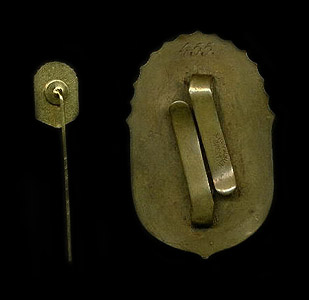
The Order of Vitez
The Hungarian "Vitezi Rend" (ORDER OF HEROES) award was created by orders of the Regent of Hungary Admiral Nicholas Horthy and instituted on 20 August 1920. This beautiful award also referred as the "Knightly Order of Bravery" shows the Hungarian coat-of-arms in full enamel color on a blue background. On the left is green oak leaves; on right, gold ears of corn.
The reverse also has two wide flat prongs integral to the badge and a three digit serial number "455."
This very high prestigious nobility award was given for military or civil distinction. It was the first public decoration after the restoration of the national government. The members of this organization that served in World War I received a large piece of land due to estate reform. They were taken up into the organization by being knighted and they use the titel vit?before their names. This title is hereditary.
The badge was worn on the left breast pocket. Recipient had the title "Vitez" (Knight), which could be passed on to his eldest son.
By 1943, over 14,000 had been awarded.
No person of Jewish faith could be a member of the order. However according to Dr. János Szentváry-Lukács some officers of jewish faith did in fact received the order. There was no term in the original document or any order for excluding jews.
A small 22mm pin was worn in civilian clothing.
It should be noted that the recipient of both awards was a German General as stated by the German dealer Detlev Niemann.
However, according to Mr. Peter Czink of the Vancouver Chapter, World Federation of Hungarian Veterans, this badge as well as the Leadership Badge were only awarded to Hungarian Nationals
|
|
The Signum Laudis Badge
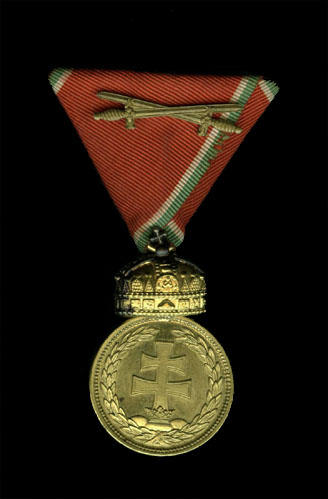
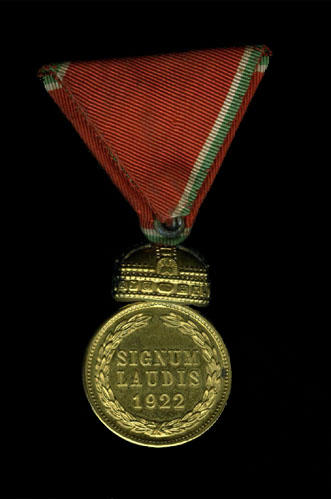
The Signum Laudis was estabilished by Horthy Miklós on 14 july 1922. As far as I know only Hungarian officers were rewarded this medal. The medal was instituted in June 1922 and was then issued in two classes: bronze and silver medal.
The ribbon for both was green with narrow white/red edges. During the same time a new higher grade was introduced: the large Gold Medal with Crown. This later is a gold oval medal with an outer edge of gilt outlined green laurel leaves. The suspension is gilt "V" shape surmounted by a gilt crown. For bravery in action, gilt swords were attached at the base of the "V" shape and on the ribbon.
By 1939 the ribbon changed to red with narrow white/green edges (known as the war ribbon).
The medal shown is a bronze type with "war decoration" ribbon and crossed swords given for bravery in action.
Awards published in the Army Gazette ("Honvédségi Közlöny") between 1 January 1939 and 31 December 1944:
Silver Signum Laudis: 64 on war ribbon and 467 with swords were issued.
Bronze Signum Laudis: 1924 on war ribbon and 4810 with swords were issued.
|
|
Combat Leadership Badge
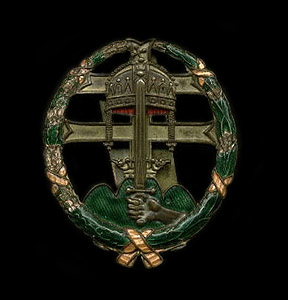
The Hungarian Officer "Csapattiszti Jelveny" (Combat Leadership) award was instituted in early 1922.
Dr. János Szentváry-Lukács stated that the Official Hungarian Gazette posted information with regulations on the award in 1922 and 1927. Also that photographs of the badge were illustrated in the Hungarian Gazette in 1928, 1935 and 1939.
The Leadership Combat Badge was issued to those officers that served directly in the Front-Line with his troops. The recipient must have served in troop strength of a regiment size or below and had served in either of the following military branches: Infantry, Calvary, Artillery, Armor, Engineering and Regimental Command.
The badge is surrounded with a green wreath and hills the rest is gilt. The center shows a hand holding a sword with the Hungarian Coat-of-arms in the background. The reverse shows two long wide flat metal prongs. Awarded for the completion of certain combat training courses and for sound leadership in battle.
|
|
Hungarian Order of Merit
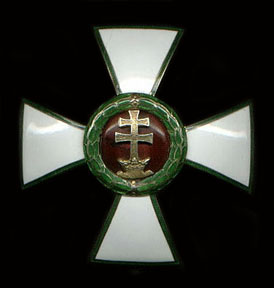 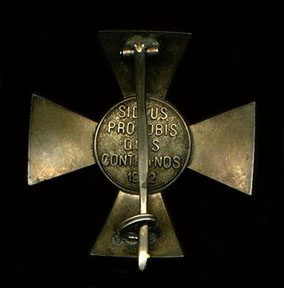
Instituted in June 1922 as the Cross of Merit in three grades: bronze, silver and gilt. Eventually the Order was expanded as follows: Knight, Officer, Commander, Grand Commander, Grand Cross and Grand Cross with Holy Crown.
The ribbon or sash for all classes was plain green. However, in 1939 the ribbon color change for combat personal to red with narrow white/green edges.
Illustrated above is the Officer grade without swords.
The cross has white enamel with gilt edges. In the center it has a gilt color double cross and hills on a red enamel background surrounded by a green laurel leaves.
The reverse shows a bronze medallion center with a Latin motto "Si Deus pro nobis quis contra nos" (If God is with us who is against us) and the year the award was instituted "1922." It also has a catch, hinge and a long pin.
For military combatants swords and green laurel leaves were added.
The Officer's cross was worn on the left breast pocket of the tunic.
|
|
Hungarian Order of the Holly Crown with Swords
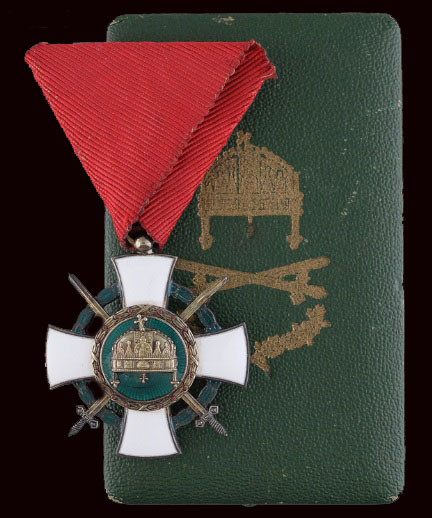
The Hungarian Order of the Holly Crown was instituted 1942, according to the Army Gazette on military awards it was instituted on March 3, 1943. For service in the kingdom of Hungary, it was awarded to foreigners who performed meritorious acts during times of peace and war. In this case it
could be assumed that most of the recipients were Germans.
The order was given in five grades: Grand Cross, Grand Officer, Commander, Officer and Knight.
The Hungarian Order of the Holy Crown with swords shown is the Knight cross and measures 43.5 mm. The cross is white enameled with a multi-piece construction.
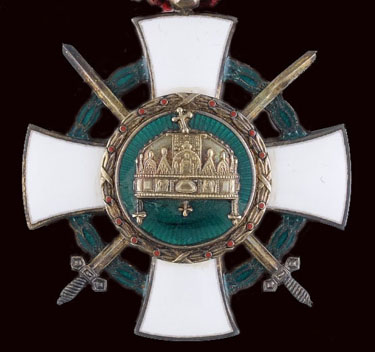
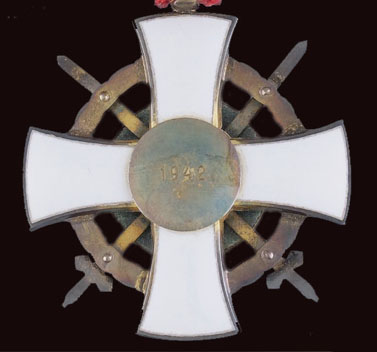
The obverse has a separate centered piece showing the
Holy Crown of Saint Stephen on a green enameled background with an outer silver wreath.
In addition to the swords it has a large size green enameled wreath that is attached to the arms of the cross.
The reverse has a silver gilt circular medallion with the year "1942" inscribed in the center.
The war red triangular ribbon is attached on the reverse side of the ring of the cross with a hook and eye. It was issued with an olive green colored hard shelled case showing the gilt monogram of the Hungarian crown with crossed swords and wreath. This particular award was issued for undertaking a meritorious act of bravery in action. It is a very rare decoration due to the late date of issue.
|
|
Hungarian Bravery Award
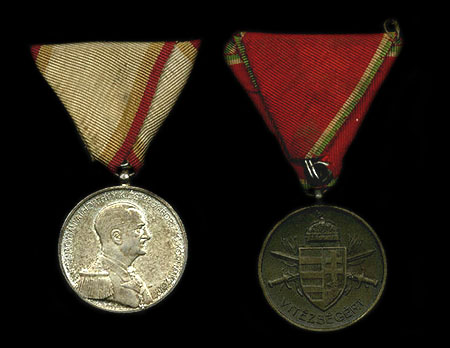
These medals, inherited from the Austria-Hungaria era, were originally instituted in 1922 in silver class only. The obverse shows the bust of the Regent, Admiral Miklos Horthy, the reverse the arms of Hungary with St. Stephen's crown above and crossed swords behind the shield.
The reverse inscription reads "VITEZSEGERT."
By 14 April 1939 (gold, large silver, small silver and bronze) awards were issued to non-commissioned officers and men.
On 12 September 1942 the gold medal for bravery Officer's award was added. The Officer's large gold medal also had a small Hungarian crown, open laurel wreath and crossed swords attached to the ribbon.
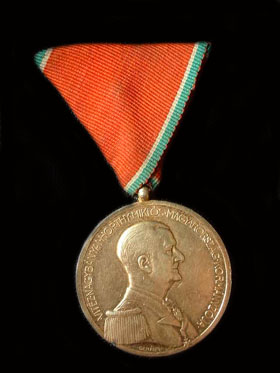
Above is a very nice rare Gold Bravery award from the collection of Mr. Charels.
|
|
The Fire Cross
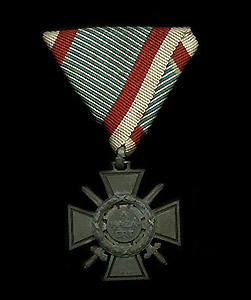
The Hungarians awarded a medal that look similar and had the same significance as the German War Merit Cross. This medal was referred as the "Fire Cross" and was instituted on the 24 November 1941 and was awarded to those who defended their homeland. No special merit was required.
Interestingly it was also rendered to wounded personnel. There were three similar types of Fire Crosses that were awarded to service men, civilians and home defense personnel. For those mobilized for home defense received a plain cross medal and a circular center piece with the inscription "AHAZAERT" (For Fatherland).
The difference in the medal for non-combatant was a circular laurel wreath surrounding the inscription. The medal illustrated is a combatant type, which has two swords crossing on opposite sides and the date "1942" listed below the cross. The plain backside shows the date "1941" inscribed in the center. The ribbon is the same for all three grades: white/green with right lateral stripes and green/red and white vertical edges.
For the wounded a horizontal bronze metal bar was attached on the ribbon.
|
|
The Hungarian Airforce
Dagger
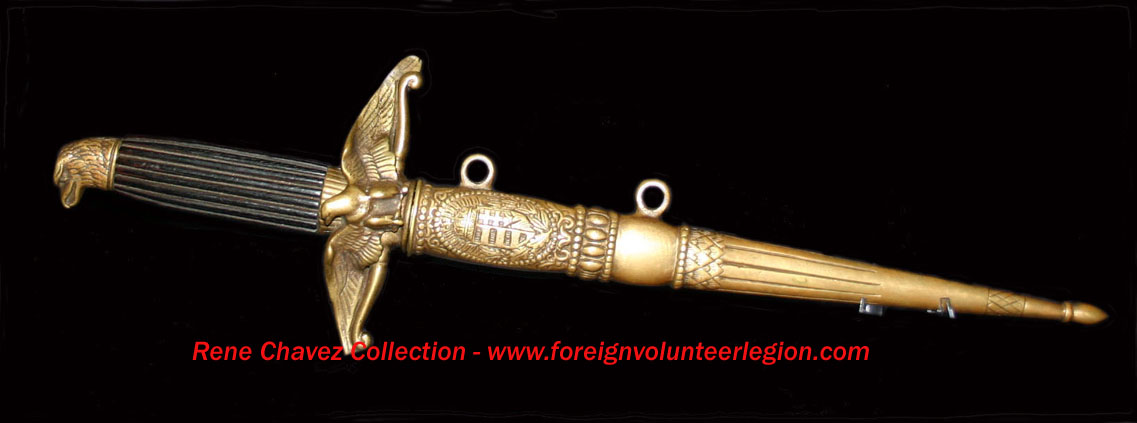

During WW2
like many of the Axis Air Forces the Hungarian Air Force was relatively small. The Royal
Hungarian Air Force flew mainly outdated or dismally performing aircraft that were provided by Germany
and Italy. For the majority of the war the Hungarian Air Force received ME-109's, FW-190's and a handful of
JU-88's, which were used during the latter stages of the war. The Royal Hungarian Air Force did produce
the dress daggers in great quantities as the officers and NCOs who would actually need one or wear one
was rather miniscule. The dagger was regulated to strictly dress and parade.
There were two forms of dress daggers. The officers dagger was finished in brass with a chromed blade
while the NCOs dagger (which are infinitely more rare than the officers) had a chrome plated body
with a brass finished eagle to create a stark contrast.
Above is a Royal Hungarian Air Force Officer Dagger. The crossguard is in form of an eagle with
outstretched wings with a black ebony wood ribbed grip tipped with an eagle head pummel. The ribbed grip
had black lacquered color.
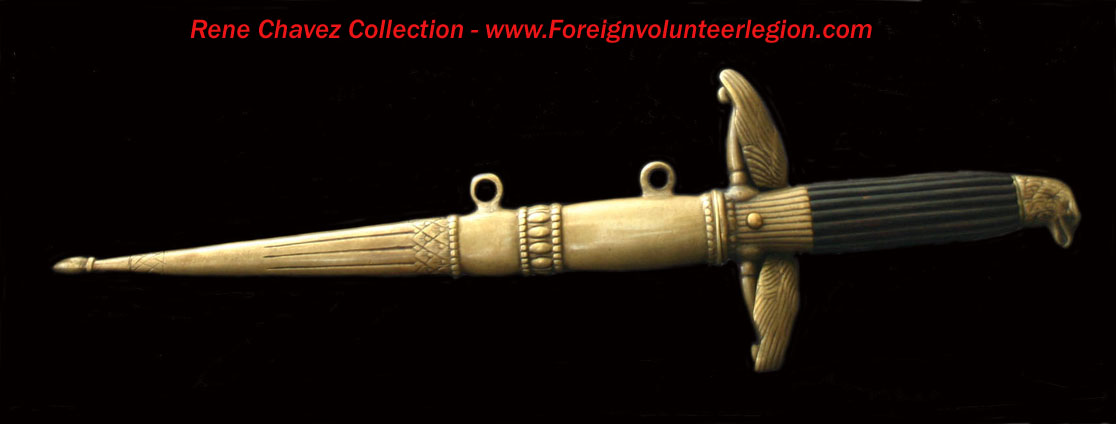 The brass scabbard is decorated with with Royal Hungarian arms within oak/laurel branches and scrolls rays
and other decorations. All hand engraved formed. Stud release button/spring functional and lock. The blade is Unmarked.
The brass scabbard is decorated with with Royal Hungarian arms within oak/laurel branches and scrolls rays
and other decorations. All hand engraved formed. Stud release button/spring functional and lock. The blade is Unmarked.
|
|
Hungarian Qualification Badges

In October 1944, new qualification badges were introduced by the Ministry of Defense. These badges are referred by collectors as
"Szálasi" badges because they were issued during his rule of the country.
These badges were made of aluminum due to the shortage of raw materials (such as copper) and were ment to be awarded on a yearly basis to soldier's with the best combat training. Each recipient had to have knowledge and handling of firearms and equipment; formal and sports training. The recipient in training was entitled to wear the badge, with cloth backing of their particular service and could displayed more then one badge at the same time.
The aim of the introduction of the qualification badges was to replace the outdated badges with ones that reflected the changes that the Royal Hungarian Army went through in the late 1930s and early 1940s, concerning training and structure.
Eight different kinds of qualification badges and four types of sports qualification badges were introduced.
Above are three qualification badges: Shown is an Infantry Heavy Weapon Squad Commander's badge; next is an Assault badge awarded to those who completed the assault course or the tank destruction course with an excellent result; last one is the expert rifleman's badge for squad members.
|
|
The Hungarian First Armored
Field Division Badge
The commemorative badge of the Hungarian 1st Armored Field Division was created to recognize the
service of those surviving veterans who were involved in the frontline during the Winter Battle Operations
that started in early January 1943. The following criteria were required:
It was awarded to those men that participated in the January 1943 winter battles fought in Marki, Nikolajevka (Nikolayev),
Ilinka (IIovskoye), Novy-ooskl (Novyi-Oskol), Michajlovka (Mecsebelovka) and Kkorotscha (Karotyak).
It was awarded to those men who were either wounded in action or injure from being exposed to the harsh winter conditions.
In addition, it was awarded to those qualified men who were either transferred from other units or subordinated to the division.
The badge was published in the official Hungarian Army Gazette dated March 25, 1943.
A certificate was issued with the badge.
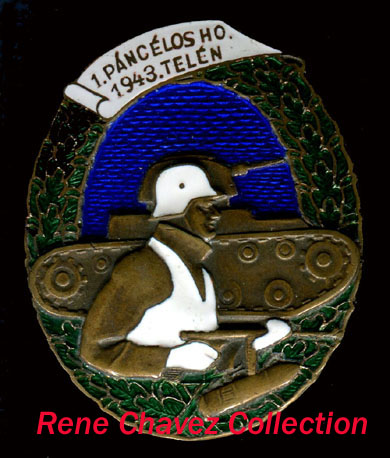
This extremely rare badge has a very interesting design and is nicely made.
The badge was made of copper aluminum alloy and gold plated. It is oval shape and convex. The badge measures 42 x 33mm. In the center it depicts in white enamel a soldier wearing winter vest with gloves and white German style helmet. The soldier is holding a machine gun. Below is an artillery shell. Behind the soldier is a bronze color Hungarian Toldi tank on a blue enameled background. The badge is surrounded by an enameled green oval wreath. On top of the wreath is a white enameled ribbon shape image with the inscription in gilt "1. Páncélos Ho./ 1943. Telén".
The reverse should have either a vertical needle pin attachment or two wide flat metal prongs.
There were two versions of the badge slightly different in the blue enameled color. One darker blue solid color and the other with cornflower light blue background. Both versions were designed by 1st Lieutenant of the 2nd Motorized shooting company Takács Gyula and 1st Lieutenant Gády Lajos. The badge illustrated is the final version. The manufacturer of the badge is unknown to the author but they were locally made in Hungary. It is very rare badge since only 200 or so where awarded to surviving tank troops and very few of these badges have been found making this one of the rarest Hungarian badges.
|
|
Szent László Hadosztály
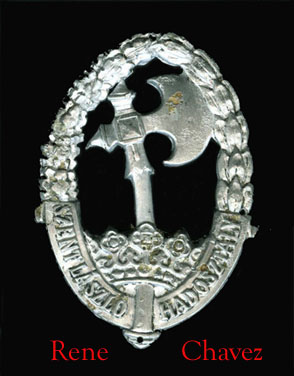
In October 1944, the Germans refitted two Hungarian Divisions: the so-called "Kossuth" Division and the “Szent Làszló" Infantry Division.
Officially formed on October 12th, 1944, decreed the 13th. This unit was named after one of Hungary's most famous saints, Szent László [ also known ad Good King Ladislaus, whom is the patron saint of Exiles and all military men. He was king of Hungary from 1077 to 1095].
Scattered units of the Hungarian infantry, naval and air force ground personnel, reserve training units, Arrow-Cross Militias and an elite parachute regiment were regrouped to form these divisions.
The "Kossuth" Division had the
101th, 102nd and 103rd Inf. Rgts. plus the 101st Artillery Rgt.
The "Szent László" Infantry Division was composed of the following:
Paratrooper Regiment:[ parachute infantry ]
1st Parachute Btl.[ Heavy Weapons Battalion],
1st and 2nd Inf. Training Rgts.,
1st and 2nd Armored Training Rgts.,
1st and 2nd Reconnaissance Training Btls.,
Anti-aircraft Btl.
and two River Defense Btls.
The "Szent László" Division, which was elevated as an elite unit was placed under the command of Major (not Brigadier) General Zoltán Szügyi from the 12th of October until May 11th 1945. It is thoughtful that at this late stage of the war that two full division where formed. Both divisions saw action defending their homeland. Remnants of the "Szent László" Infantry Division retreated towards the Drava valley in Croatia and later in Carinthia, Austria where it surrendered to the British.
Volunteers of the "Szent László" Infantry Division wore a large oval metal aluminum badge showing a battleaxe and a crown, and, on a scroll at the base, the words indicating the "Szent László" Division. The badge shown above are consider very rare. This badge was found near the town of Esztergom.
|
[ Front Page] [Top ] [Previous Page] [Next Page]
|


















